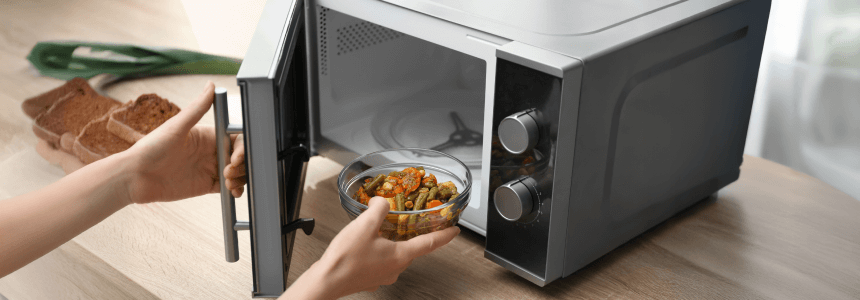
Contemplating coverage?
Subscribe to receive our emails & get
$200 OFF!
Have questions?
Call us: (833) 544-8273


Written By Rachel Cherem
Sometimes—Here’s What to Know
If you’ve ever stood in front of your microwave, leftovers in hand, wondering if you can microwave your glass—you’re not alone. It’s a common question for homeowners and renters alike. While many glass containers are perfectly safe for the microwave, others can crack, shatter, or even leach chemicals if they’re not designed for heat.
The short answer? Yes, you can microwave glass, but only if it’s labeled microwave-safe. The longer answer involves understanding the different types of glass, how they react to heat, and what precautions you should take to avoid kitchen mishaps.
Glass is generally considered one of the best materials for heating food because it doesn’t absorb microwave energy. However, not all glass is created equal. The key factor is whether it’s tempered or treated to handle high heat.
Microwave-safe glass is specifically made to withstand sudden temperature changes without cracking. Common examples include borosilicate glass like Pyrex or Anchor Hocking, tempered glass cookware, and microwave-safe glass storage containers.
You’ll usually see a label or symbol on the bottom of the dish that says “microwave-safe.” If there’s no marking, it’s best to test or avoid microwaving it altogether.
Not sure whether your favorite glass bowl or mug is microwave-safe? Here’s a simple test you can do:
Safety tip: Always use oven mitts or a towel when performing this test. Some glasses can heat up unexpectedly.
Even microwave-safe glass has its limits. Here are a few times when microwaving glass isn’t a good idea:
Putting a cold or frozen glass dish directly into a hot microwave can cause thermal shock, leading to cracks or shattering. Always let the glass warm to room temperature first.
Small imperfections can quickly expand under heat. Even minor cracks weaken the structure of the glass and can cause it to break during heating.
Metallic decorations, gold rims, or even small metal logos can cause sparks in the microwave and potentially damage the appliance.
If there’s no marking, err on the side of caution. Some decorative or thin glassware isn’t designed for high heat and could fracture.
The microwave makes reheating and cooking convenient, but not every kitchen item belongs inside. If you’re wondering what can go in the microwave, here’s a quick guide to help you keep your appliance and your food safe.
Even microwave-safe glass has limits when it comes to exposure time and temperature. Here’s what to keep in mind:
Also, always use caution when removing glass from the microwave—steam burns are more common than you might think.
Glass shattering in the microwave can be startling and dangerous. The most common reasons include thermal shock which is a sudden change from cold to hot, hidden defects or hairline cracks in the glass, uneven heating of thick glass dishes, and overheating without food or liquid inside. To minimize risk, never microwave empty glass containers, and avoid heating glass that’s been in the fridge or freezer.
When deciding what can go in the microwave, glass is often the better choice over plastic. Here’s why:
Feature | Glass | Plastic |
Heat Resistance | Excellent (if microwave-safe) | Can melt or warp |
Chemical Safety | Non-reactive | Some plastics may leach chemicals |
Longevity | Long-lasting | Shorter lifespan |
Taste/Odor Retention | Doesn’t retain odors | May absorb smells over time |
So while both can be microwave-safe, glass is typically safer, more durable, and better for the environment.
To safely microwave glass containers, follow these best practices:
These small steps can help extend the life of your glassware and prevent accidents.
So, can you microwave glass? Yes, but with caution. As long as your glassware is labeled microwave-safe, free of cracks, and used properly, it’s one of the safest and most effective materials for reheating and cooking food.
If you’re ever unsure, take a moment to test the dish or transfer your food to a clearly labeled microwave-safe container.
At Liberty Home Guard, we believe that safe and functional appliances are key to a happy home. From your microwave to your dishwasher, our home warranty plans help protect the systems and appliances you rely on every day.
Learn more about how a Liberty Home Guard home warrantycan give you peace of mind and keep your kitchen running smoothly. Get a free quote today!
There’s a reason Liberty Home Guard was rated the #1 Home Warranty
Service by U.S. News and World Report for 2021, 2022, 2023, and 2024. Check out our services.
Stay Ahead of Potential
Home Mishaps!
Subscribe to our Liberty Home Guard Newsletter and gain access to exclusive content that ensures your peace of mind.